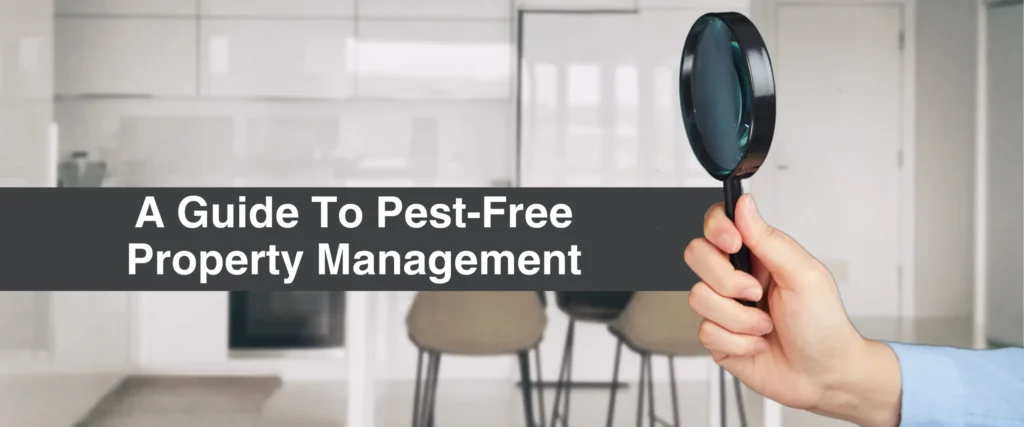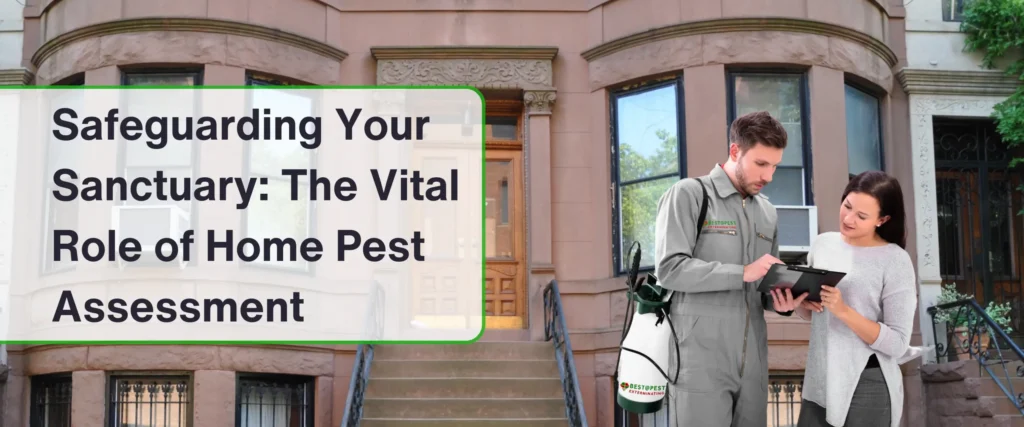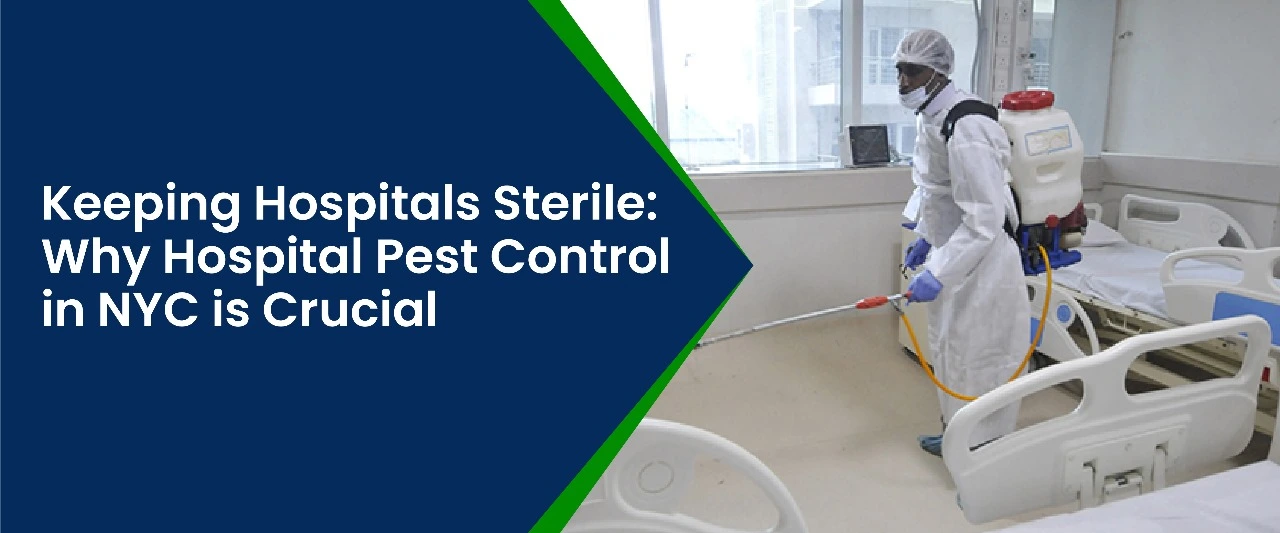
Keeping Hospitals Sterile: Why Hospital Pest Control in NYC is Crucial
Keeping the Frontline Sterile: Unique Challenges and Solutions
Imagine a place dedicated to healing, where hygiene is paramount. Now, picture unwelcome guests – pests – roaming the halls. This unsettling scenario is a very real concern for hospitals in New York City, where densely populated environments and constant human traffic create a breeding ground for unwanted visitors. Effective pest control in NYC hospitals becomes not just a matter of aesthetics, but one of critical importance for patient safety, regulatory compliance, and the overall reputation of the facility.
Why Pest Control In Hospital Is Crucial
- Health and Safety Concerns: Hospitals are havens for vulnerable individuals, many with compromised immune systems. Pests like roaches, flies, and rodents can carry and transmit diseases like salmonella, E. coli, and even hantavirus. Their presence can also trigger allergies and asthma attacks in patients and staff. In a sterile environment where even minor infections can be life-threatening, pests pose a significant risk.
- Regulatory Requirements: Hospitals must adhere to strict health regulations set by agencies like the Joint Commission International (JCI) and the New York State Department of Health (NYSDH). These guidelines mandate the implementation of comprehensive pest management programs to ensure the safety and well-being of patients. Failure to comply can result in fines and even closure of the facility.
- Reputation Management: A pest sighting in a hospital can be disastrous for its public image. News travels fast, and a single incident can erode patient trust and damage the facility’s reputation for years to come. A proactive approach to pest control is essential to maintaining public confidence and ensuring a positive patient experience.
Case Study: A Hospital’s Nightmare
In 2019, a prestigious hospital in Chicago made headlines after a severe bed bug infestation forced the closure of an entire wing. The incident not only caused distress to patients but also resulted in significant financial losses due to treatment costs and room closures. This case serves as a stark reminder of the consequences of neglecting pest control in a healthcare setting.
Common Pests Found in Hospitals and How They Get In
Unwelcome Guests: A Rogues’ Gallery of Hospital Pests
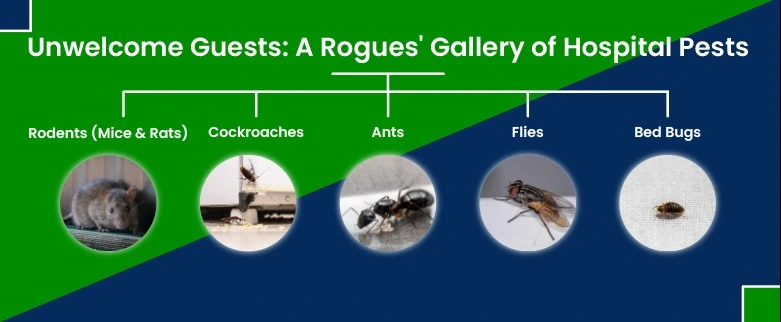
Hospitals, unfortunately, can be attractive to a variety of creepy crawlies. Here are some of the most common NYC hospital pests and the problems they create:
- Rodents (Mice & Rats): These notorious hitchhikers carry a multitude of diseases and can contaminate food and surfaces with their droppings. Their constant gnawing can also damage electrical wiring and infrastructure.
- Cockroaches: These resilient insects are notorious for spreading bacteria and triggering allergies. They thrive in damp environments and can contaminate food preparation areas.
- Ants: While some ant species are relatively harmless, others can bite and leave itchy welts. They can also contaminate food and disrupt sterile environments.
- Bed Bugs: These blood-sucking insects are a growing concern in NYC hospitals. They can infest beds, furniture, and even medical equipment, causing distress and hindering patient recovery.
- Flies: These buzzing annoyances not only disrupt patient comfort but can also transmit diseases like food poisoning.
How These Pests Infiltrate the Hospital
Now that we know the unwelcome guests, let’s see how they gain entry:
- Delivery Openings: Loading docks and trash areas are prime entry points for rodents and roaches.
- Cracks and Gaps: Small openings around pipes, windows, and doors allow pests to sneak inside.
- Patient Belongings: Used clothing, luggage, and even flowers can unknowingly harbor bed bugs.
- Improper Waste Management: Overflowing trash bins and unsanitary food disposal areas attract and sustain pest populations.
Keeping Pests Out: An Ounce of Prevention
Hospitals can significantly reduce the risk of infestation by implementing these preventive measures:
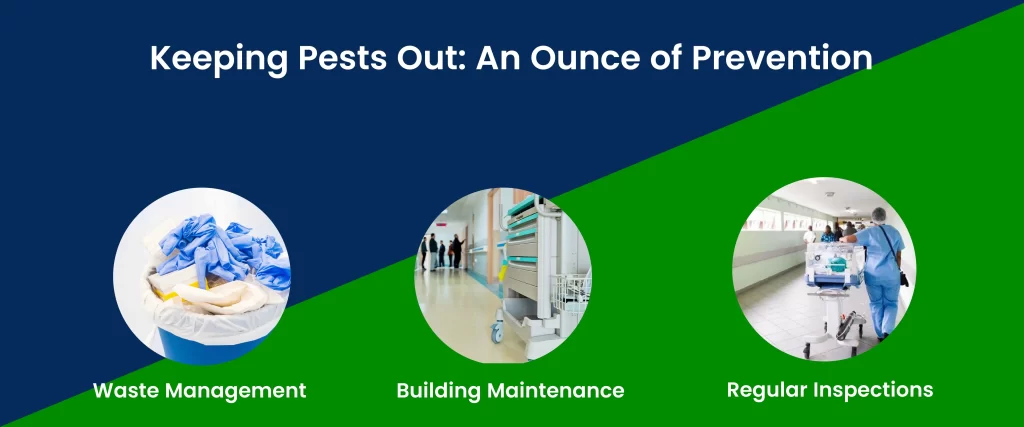
- Regular Inspections: Schedule regular inspections by qualified pest control professionals to identify potential entry points and early signs of pest activity.
- Building Maintenance: Seal cracks, repair damaged screens, and ensure proper ventilation to eliminate potential pest havens.
- Waste Management: Maintain strict protocols for waste disposal, including frequent emptying of trash bins and proper food waste management.
Taming the Tide: Effective Pest Control Measures in Hospitals
Integrated Pest Management (IPM): A Smarter Approach
Hospitals require a specialized approach to pest control. Here’s where Integrated Pest Management (IPM) comes in. IPM is a holistic strategy that focuses on prevention, monitoring, and targeted interventions to control pest populations with minimal environmental impact.
The Steps of IPM in a Hospital Setting:
- Inspection and Identification: A thorough inspection by a qualified pest control professional helps identify the type of pest, its entry points, and potential breeding areas.
- Monitoring: Hospitals implement monitoring systems like traps and bait stations to track pest activity and assess the effectiveness of control measures.
- Non-Chemical Controls: This stage prioritizes physical barriers, sanitation practices, and habitat modification to prevent pest establishment.
- Targeted Chemical Control: When necessary, pest control professionals use EPA-approved hospital-grade pesticides with minimal human health risk.
- Documentation and Evaluation: Detailed records are kept of all pest control activities, allowing for ongoing evaluation and adjustments to the IPM program.
Staff Training: Eyes on the Ground
A critical component of hospital pest control is educating staff on pest identification, prevention, and reporting procedures. Training programs should cover topics like:
- Recognizing common pests and their signs
- Reporting any pest sightings immediately
- Maintaining proper sanitation practices in their work areas
- The importance of storing food and belongings properly
By empowering staff to be vigilant and proactive, hospitals can create a culture of prevention that significantly reduces the risk of pest infestations.
Battling the Invaders: Safe and Effective Pest Control Methods in Hospitals
The Arsenal Against Infestation: A Multi-Pronged Approach
Hospitals require a multi-layered approach to pest control, prioritizing safety and effectiveness. Here’s a breakdown of the primary methods used:
- Physical Methods: These methods focus on physically excluding pests or capturing them without chemicals. Common tools include:
- Traps: Snap traps, glue traps, and bait stations can effectively target specific pests like rodents and insects.
- Barriers: Sealing cracks and gaps around doors, windows, and pipes prevents pests from entering in the first place.
- Insect Light Traps: Ultraviolet light attracts flying insects, eliminating them hygienically.
- Biological Methods: This eco-friendly approach utilizes natural predators to control pest populations. For example, introducing parasitic wasps can target bed bug infestations.
- Chemical Methods: While the last resort, hospital-grade pesticides play a vital role in eliminating established pest populations. Here’s what to consider:
Chemicals In Sensitive Environments: Pest Control Chemicals Used In Hospitals
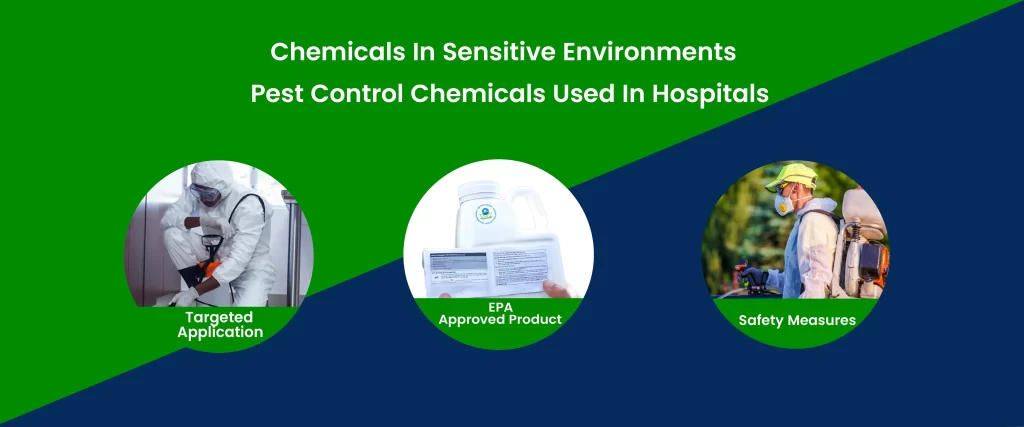
- EPA-Approved Products: Hospitals only use pesticides approved by the Environmental Protection Agency (EPA) for use in healthcare settings. These products are rigorously tested to ensure minimal risk to human health.
- Targeted Application: Pest control professionals apply pesticides strategically to minimize exposure for patients and staff.
- Safety Measures: Strict protocols are followed during pesticide application, including patient relocation, proper ventilation, and the use of personal protective equipment (PPE).
Beyond Chemicals: Eco-Friendly Alternatives
Hospitals are increasingly exploring eco-friendly alternatives to traditional pesticides. These include:
- Diatomaceous Earth: This naturally occurring powder dehydrates insects, killing them without introducing harmful chemicals.
- Botanical Insecticides: Extracts from plants like pyrethrum can offer a less toxic option for insect control.
When the Big Guns Come Out: Fumigation And Pesticide Control In Hospitals
Fumigation: A Last Resort
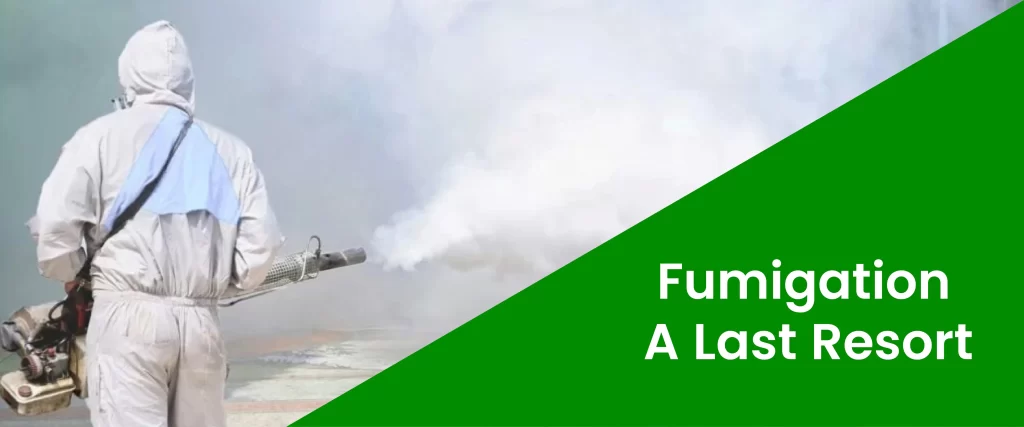
In cases of severe infestation, hospitals may resort to fumigation. This process involves saturating the environment with a potent gas to eliminate all life stages of the pest.
- Necessary Situations: Fumigation is typically used for bed bug infestations or when other methods have proven ineffective.
- Safety First: Fumigation requires meticulous planning and execution. The hospital must be completely evacuated, and stringent safety protocols must be followed to ensure patient and staff well-being before, during, and after the process.
Pesticide Control: Striking a Balance
Hospitals walk a tightrope between effective pest control and patient safety. Here’s how they achieve this balance:
- Choosing the Right Products: Pest control professionals select pesticides with minimal toxicity and residual effects for use in healthcare settings.
- Targeted Application: Pesticides are applied only in designated areas and during periods when patient exposure is minimized.
Post-Treatment Follow-Up: Maintaining Vigilance
The battle against pests isn’t over after treatment. Here’s how hospitals ensure continued safety:
- Follow-up Inspections: Regular inspections by pest control professionals are crucial to identify any resurgence of pest activity.
- Ongoing Monitoring: Hospitals maintain monitoring systems like traps and bait stations to detect any new pest incursions.
- Patient and Staff Safety: Hospitals communicate post-treatment procedures to ensure patient and staff safety after any chemical application.
Partnering for Protection: Choosing the Right Pest Control Service in NYC
Finding Your Guardian Against Pests
Selecting the right pest control service is critical for safeguarding your hospital’s environment. Here’s what to look for:
- Licensing and Certifications: Ensure the company holds all necessary licenses and certifications from the New York State Department of Environmental Conservation (NYSDEC) for operating in healthcare facilities. Technicians should be certified applicators, trained in the safe and effective use of hospital-grade pesticides.
- Experience and Reputation: Look for a company with proven experience in handling sensitive hospital environments. Seek references or online reviews from other NYC hospitals to gauge their reputation and service quality.
Best@Pest Exterminating: Protecting What Matters Most
At Best@Pest Exterminating, we understand the unique challenges faced by NYC hospitals. We offer a comprehensive pest control program specifically designed for healthcare settings. Our team of highly trained and certified technicians utilizes the latest IPM strategies and hospital-grade products to ensure patient and staff safety.
Contact Us Today: Proactive Prevention is Key
Don’t wait for a pest infestation to disrupt your hospital’s operations. Contact Best@Pest Exterminating today for consultation. Our experts will assess your specific needs and develop a customized pest control program to ensure a safe and healthy environment for your patients and staff.
Conclusion: Safeguarding Your Patients, Your Reputation
Effective pest control in NYC hospitals is not just about aesthetics; it’s about patient safety, regulatory compliance, and public trust. By implementing a comprehensive IPM program that prioritizes prevention, monitoring, and safe intervention methods, hospitals can create a pest-free environment for healing.
Remember, proactive pest management is essential to protecting your patients, your staff, and your hospital’s reputation. Don’t wait for an infestation – contact us today and let our expertise become your shield against unwanted visitors.

